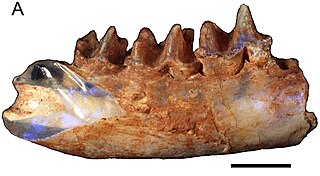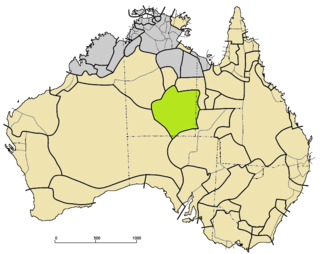
The Dreaming, also referred to as Dreamtime, is a term devised by early anthropologists to refer to a religio-cultural worldview attributed to Australian Aboriginal mythology. It was originally used by Francis Gillen, quickly adopted by his colleague Sir Baldwin Spencer and thereafter popularised by A. P. Elkin, who, however, later revised his views.

Steropodon is a genus of prehistoric platypus-like monotreme, or egg-laying mammal. It contains a single species, Steropodon galmani, that lived about 100.2–96.6 million years ago during the Cretaceous period, from early to middle Cenomanian. It is one of the oldest monotremes discovered, and is one of the oldest Australian mammal discoveries. Several other monotremes are known from the Griman Creek Formation, including Dharragarra, Kollikodon, Opalios, Parvopalus, and Stirtodon.

Hermannsburg, also known as Ntaria, is an Aboriginal community in Ljirapinta Ward of the MacDonnell Shire in the Northern Territory of Australia, 125 kilometres (78 mi); west southwest of Alice Springs, on the Finke River, in the traditional lands of the Western Arrarnta people.

Sir Walter Baldwin Spencer, commonly referred to as Sir Baldwin Spencer, was a British-Australian evolutionary biologist, anthropologist and ethnologist. He is known for his fieldwork with Aboriginal peoples in Central Australia, contributions to the study of ethnography, and academic collaborations with Frank Gillen. Spencer introduced the study of zoology at the University of Melbourne and held the title of Emeritus Professor until his death in 1929. He was elected a Fellow of the Royal Society in 1900 and knighted in 1916.
Theodor George Henry Strehlow was an Australian anthropologist and linguist. He studied the Arrernte Aboriginal Australians and their language in Central Australia.

Rapator is a genus of theropod dinosaur from the Griman Creek Formation of New South Wales, Australia, dating to the Cenomanian age of the Cretaceous period. It contains only the type species, Rapator ornitholestoides, which was originally named by Friedrich von Huene in 1932.

Arandaspis prionotolepis is an extinct species of jawless fish that lived in the Ordovician period, about 480 to 470 million years ago. Its remains were found in the Stairway Sandstone near Alice Springs, Australia in 1959, but it was not determined that they were the oldest known vertebrates until the late 1960s. Arandaspis is named after a local Indigenous Australian people, the Aranda.

Francis James Gillen, also known as Frank Gillen and F. J. Gillen, was an early Australian anthropologist and ethnologist. He is known for his work with W. Baldwin Spencer, including their seminal work The Native Tribes of Central Australia (1899). They both worked in central Australia, where Gillen was employed as a telegraph station master, with the Arrernte people and other Indigenous Australians.

Arrernte or Aranda, or sometimes referred to as Upper Arrernte, is a dialect cluster in the Arandic language group spoken in parts of the Northern Territory, Australia, by the Arrernte people. Other spelling variations are Arunta or Arrarnta, and all of the dialects have multiple other names.

The Arrerntepeople, sometimes referred to as the Aranda, Arunta or Arrarnta, are a group of Aboriginal Australian peoples who live in the Arrernte lands, at Mparntwe and surrounding areas of the Central Australia region of the Northern Territory. Many still speak one of the various Arrernte dialects. Some Arrernte live in other areas far from their homeland, including the major Australian cities and overseas.
Moritz Freiherr von Leonhardi was a German anthropologist.
Psilichthys is an extinct genus of prehistoric bony fish from Eumeralla Formation, the Lower Cretaceous epoch of what is now Victoria, Australia, known from single species P. selwyni. This is the first Mesozoic fossil vertebrate named from Victoria.
The Anmatyerr are an Aboriginal Australian people of the Northern Territory, who speak one of the Upper Arrernte languages.
Cyclodendron was a genus of lycophytes dating from the Permian. Plants were vascularized with reproduction by spores.
Arrernte Sign Language, or Aranda Sign Language, also known as Iltyeme-iltyeme (handsigns), is a highly developed Australian Aboriginal sign language used by the Arrernte people of central Australia.

Kulpara is a rural town in South Australia, situated on the Copper Coast Highway and Upper Yorke Road in the Hummocks Range at the northern end of Yorke Peninsula.

The Luritja or Loritja people, also known as Kukatja or Kukatja-Luritja, are an Aboriginal Australian people of the Northern Territory. Their traditional lands are immediately west of the Derwent River, that forms a frontier with the Arrernte people, with their lands covering some 27,000 square kilometres (10,300 sq mi). Their language is the Luritja dialect, a Western Desert language.
The Yumu were an Indigenous Australian people of the Northern Territory.
Gascoyne Seamount, also called Gascoyne Guyot or Gascoyne Tablemount, is a guyot in the Tasman Sea of the South Pacific Ocean.
McGraths Flat is an Australian research site containing fossils and other evidence of animals and plants that existed in Miocene Australia. Located in central New South Wales, specimens at the site are in an exceptional state of preservation, described in paleontology as a Konservat-Lagerstätten, deposited in unusual conditions that record microscopic details of soft tissues and delicate structures. Fossil evidence of animals with soft bodies, unlike the bones of mammals and reptiles, is rare in Australia, and discoveries at McGraths' Flat have revealed unknown species of invertebrates such as insects and spiders.










